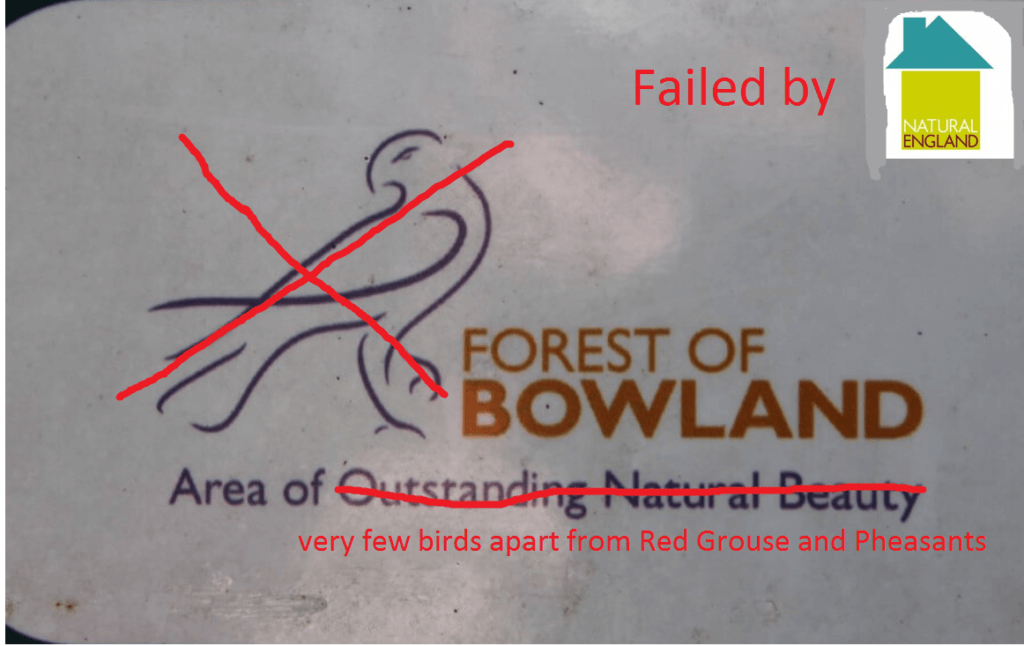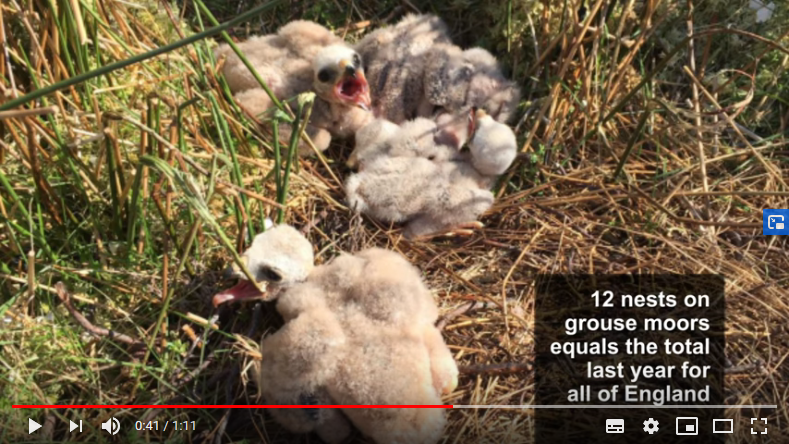
The Moorland Association is trying to big up the Hen Harrier breeding season already – and it’s only late June!
If you shouldn’t count your chickens before they’re hatched you certainly shouldn’t count your Hen Harriers before they are fledged (naturally, in the wild) and even then you shouldn’t count on them surviving.
Here is the short video from the Moorland Association which is well worth watching because it has some distant but decent footage of Hen Harriers in it.
The Moorland Association is claiming 6 nests on grouse moors in Lancashire, 4 in Cumbria and 2 in the whole of Yorkshire.
I wonder how many nests are on the Lancashire grouse moor of the Duke of Westminster in the Forest of Bowland this year. Last year there were none. The year before there were none. In 2017 there were none. In 2016 there were none. Let’s be clear about this, as I understand it, and nobody has sought to deny this, his Grace (and his father before him) has had no Hen Harriers nesting on his grouse moor in the Forest of Bowland, once the stronghold of the species in England since … 2003 – see blog Poor Old Duke from August last year. Let’s hope that his Grace has broken his duck in this 17-year run of zeroes. It’s spectacularly unlucky.

Assuming that Bowland has something like the number of nests that it had last year (5) it will be interesting to see how many of them are on United Utilities land which is always counted by the Moorland Association as a grouse moor, but not really by anyone else as its main function in life is to produce clean water rather than large grouse bags.
So we are used to discounting the claims of the Moorland Association of this sort;

Most Hen Harriers do not live on grouse moors – about 30,000 pairs nest in Russia for a start! But most Hen Harriers in the UK don’t live on grouse moors either. And do most Hen Harriers in England live on grouse moors? Well, as we have already seen, it depends what you call a grouse moor and the Moorland Association bend the truth. What we do know from science is that most Hen Harriers die on grouse moors – and that’s a very different kettle of fish.
Are other ‘birds of prey doing well on grouse moors’? Hardly, just glance through the annals of Raptor Persecution UK’s blog or follow them on Twitter @RaptorPersScot

You will see that the Moorland Association is claiming that the number of nests on grouse moors (according to them) ‘equals the total for all of England last year’ but that isn’t true. It’s very simply a misrepresentation. There were 12 successful nests in the whole of England last year, not 12 nests – and we won’t know how many successful nests there are this year until much later in the year.
You can see that this is the case because of when Hen Harriers have satellite tags fitted, its usually in the week before they fledge. The tagging dates from Natural England work are publicly available. The earliest data I spotted was 16 June, many are in July, and some are in August (and these are not-yet-fledged birds). So it is wildly premature to count your Hen Harriers now, so long before fledging. And that’s why the end of season figures usually emerge just before Hen Harrier Day not before the summer solstice!
This casual relationship with the facts makes the Moorland Association a very dodgy partner of Natural England. NE’s own reputation is dragged down by its association with this lot. And the fact that NE seems completely happy with this twaddle, over a long period of time, speaks volumes. It doesn’t speak well of NE, just volumes.
The truest words that Amanda Anderson ever said for the Moorland Association to illustrate their real feeling for this protected bird were:
If we let the hen harrier in, we will soon have nothing else.’
The times, 7 August 2016. https://www.thetimes.co.uk/article/battery-farm-to-bring-hen-harriers-back-from-the-brink-lw77qcs5t
Let’s hope that there are lots of Hen Harrier nests this year, and let’s hope they are successful, but we’d better wait until they have run the gauntlet of natural predation by Red Foxes (which even happens sometimes on grouse moors, I bet), the impacts of periods of poor weather (like the recent heavy storms in some parts of the uplands) and all the other things that can remove Hen Harrier nests from the moors – oh yes, brood meddling included!
[registration_form]
Lets look at this again 6 in Lancashire, I’d be surprised if there were any away from United Utilities land, 4 in Cumbria. Cumbria of course is a county with a huge area of grouse moors ( not really) but only 2 in Yorkshire. Yorkshire has a huge area of grouse moors, the biggest area in England what with the Yorkshire Dales NP, Nidderdale AONB and North York Moors never mind the grouse moors of West and South Yorkshire several parts of the South Pennines SPA or Peak District and this whole area holds , wait for it, TWO nest of Hen Harriers. I bet neither of them are on the Clapham Estate moors in the Yorkshire bit of Bowland ( remember White Syke) or on Threshfield Moor.
Don’t get me wrong I want them to succeed without either of them having their young stolen ( sorry brood meddled) no I was right first time stolen. There should be 100+ pairs in Yorkshire alone , well I knew the MA had low standards ( truth, honesty to start with) but bragging about two whole pairs of Hen Harriers in all of Yorkshire. In 2003 there were 6 nests in one moorland area of North Yorkshire alone, admittedly the dark side made sure 4 failed and two only survived to fledging because of polygamy ( they saw 4 males and did 4 nests).
Some real Honesty please Amanda ( if you can remember what that’s like!) Bowland incidentally once had 40 yes 40 breeding females so please don’t brag about record numbers again ( until we get back to that number )!!
Fallacy of the undistributed middle:
Most hen harriers live on grouse moors
Birds of prey are doing well on grouse moors
So hen harriers are doing well on grouse moors.
Leaving aside whether either of the two premises of the syllogism are correct, the conclusion is self-evidently false in logic. As well as wholly unevidenced of course.
Alan – indeed
If there are loads and loads of Hen Harrier chicks on English grouse moors this year that survive into maturity, that would be great.
Unfortunately what Amanda says and what is actually delivered are usually at odds with reality. I very much agree with Mark’s experience and caution at this juncture.
This is an industry that after all releases circa 45 million pheasants, 10 million partridge and shoots half a million natural red grouse each and every year. 12 hen harrier nests on active grouse moors in comparison doesn’t seem a great deal to boast about does it? It would however mark a welcome small change in direction.
Lets go back to last September and another quote from Amanda.
“Satellite data from an innovative scheme to help boost England’s Hen Harrier population has shed new light on the activities of the birds at the centre of the initiative.
Amanda Anderson, Director of the Moorland Association, which is a partner in the brood management scheme trial, said: “This data provides a fascinating insight into the behaviour of these captive-reared young harriers. Most of the birds have been content to fly around the uplands and grouse moors which is territory they know and like. The adventures of the birds which travelled further afield are extraordinary and show that the species is quite capable of covering vast distances”.
All 5 went missing/their trackers stopped working/they are dead/they are resting*
* delete as appropriate.
Have we reached a tipping point?
President Johnson when he was running the Vietnam war at its height had, what was know in the US as “ a very large credibility gap” and in the end the war was lost. Amanda Anderson is, I would suggest, is in a similar situation.
By the way, very many commiserations to the Duke of Westminster for not having any nesting Hen Harriers on his land. I wonder why that is??? What a disgrace.
Two in NY…very soon harriers will be blocking out the sun like locusts in the fair county of God. Still, they can always net the surplus and fling them out into northumberland and durham, who are evidently doing something wrong. I always like that quote from Amanda vis Enoch… “if we let the harrier in”. She must see a long line waiting patiently at the moorland edge, papers and little tattered suitcases in hand, applying to get in – to their own home! I don’t think George Orwell ever mentioned DGS in 1984 – so where do the MA get their material?
There will no doubt be birds in Northumberland but they have the temerity fortunately to nest on FC land and not on grouse moors, so Amanda doesn’t count those.
The northern part of the North Pennines SPA is by all accounts a complete and utter black hole for moorland raptors other than Merlin. Time the spotlight of truth was shone into its very dark and bloody corners.
Agreed, if the landowners & keepers in the remote parts of the north pennines got a fraction of the scrutiny that their counterparts in the peak district get (by virtue of proximity to folk around Sheffield,etc), then somebody had better start a whole new blog as this one & RPUK would be swamped.
The sound of gunshots in the video’s backing music is quite accurate.
Most Hen Harriers die on grouse moors, too, usually before they’ve had a chance to breed.